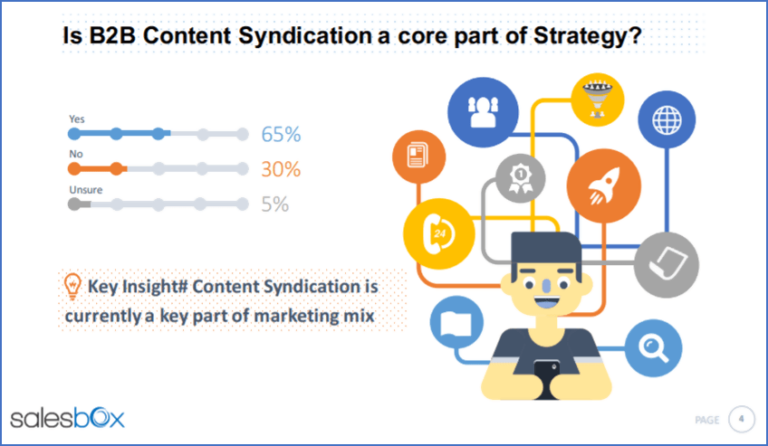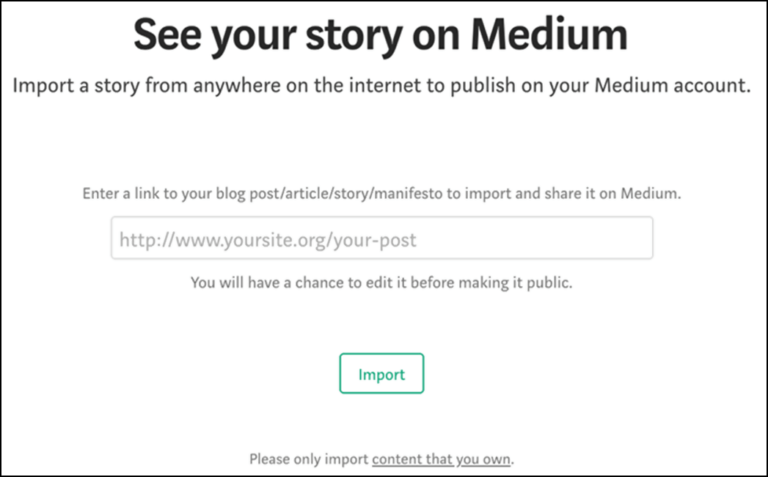
Introduction
For a b2b marketer, relying on a marketing strategy that features a variety of tactics can mean more awareness for your brand, ensure more reach and result in more sales leads. Key among those tactics should be Content syndication. It is a marketing tactic that involves distributing content that you have published on your digital assets, to be republished on third party websites.🌐
While some companies will publish your content on their website for free, other websites, especially high-authority sites, do so for a fee.
By 2016, at least 65% of demand generation marketers were already using content syndication, according to a survey conducted by Salesbox.

If you aren’t already syndicating content, you should consider employing this method of content marketing for these reasons:
- You can leverage the same content several times
- A lot of syndicating sites have a large following hence your content is likely to be more visible
- Your content will experience a longer shelf life
- Publishing content on other sites improves your image as an authority
- It keeps you top-of-mind should readers ever need your product or service
- It allows you to tap into a new audience
Different syndicating sites have different guidelines for syndication. Some may publish the whole article while others may publish a part of it or a version of the same.
Concerns With Duplicate Content
One of the key concerns raised around content syndication is duplicate content. Whereas content syndication means that there will be more than one version of your blog circulating in the internet, as long as you work on your SEO, this shouldn’t be a problem.😉
Note that contrary to the view that Google will penalize you for duplicate content, when syndicating, what happens is that only one of the versions (preferably the original one published on your site), will be indexed. But you have to put in some work to ensure this happens.
We will show you later in this article, how to work on your SEO when syndicating content, to ensure your original content gets the most visibility. We will also discuss best practices for content syndication.
Why Content Syndication?
Your company’s blog should be the center of your content marketing strategy; all traffic should lead back to your blog or website. But, when starting out, it will take more than publishing content on your own site to get inbound traffic. You will need to leverage other sites that have traffic. Hence the need for content syndication to get new audiences for your brand a lot faster.
This simple fact does not however negate the benefits of other efforts such as SEO and content promotion. But on their own, these tactics will take some time to show results.

What Will Content Syndication Do and What Won’t It Do?
Before you come up with a content syndication strategy for lead generation, it’s important to understand what it will do and what it won’t do.
There is the obvious fact that by publishing content on another website, you will be benefitting that website. It is not guaranteed that people will click on your link; they may just read your article on the syndicating site and not visit your site. This is a sacrifice that will make sense to you depending on your priorities.
If your priority is referral traffic, other content marketing strategies may work better than content syndication. If you want your ideas and brand to be discovered by large audiences, then content syndication is the way to go. With time, as your content gets more shares, as your brand builds more equity and as people begin to recognize you for your thought leadership, you will experience more follows and even clicks to your site.
The beauty of content syndication is that it generates leads for you by building the readers’ perception about your brand. That is, to the reader, your ideas are found on an authority site, ergo, you are an expert who they should connect with, follow or consult.
Top 3 Main Content Syndication Tips
To come up with a winning content syndication strategy for lead generation, follow these tips:👇
1. Ask Yourself, “What is My Content Syndication Strategy?”
To answer this question
First, you need to establish your goals. That is, what do you want to achieve with content syndication? As mentioned above, there are certain objectives that syndicating content is most suitable for. As such, having clear goals will help you decide how to run your product content syndication campaign. For example, if you want leads, syndicating an excerpt of your article is a better strategy than posting a whole article.
Second, consider the content you have:
- Will it fulfill the requirements of the syndication partners?
- Will stand out on the syndication websites?
- Will it serve your goals?
Lastly, decide Where to syndicate
One of the most important things to consider when coming up with a content syndication strategy is where to syndicate. It makes no sense to syndicate to a site with millions of traffic if your target audience doesn’t spend time there. The following are some suggested outlets suitable for b2b content syndication:
- Blogs that feature multiple authors. For instance, Business2Community
- Social networks. LinkedIN, Quora, Facebook (Instant article and Notes)
- Blogging platforms. Medium and Tumblr are good examples.
To find the right platform to syndicate your content:
- Research content syndication vendors to assess their suitability for your industry, audience and type of content.
- Read testimonials of businesses that have succeeded syndicating on those sites. Reviews and testimonials that feature real analytics such as conversions or sales data are more credible.
- Syndicate on a website that has more traffic than yours. You can also syndicate on a website that matches your traffic levels if your objective is to take advantage of new audience types.
2. Choose Your Publishing Time Wisely
Choosing your timing wisely will help you achieve maximum visibility for your original post. If you publish to your site and also syndicate at the same time, your syndicated post may end up ranking better because of all the traffic and authority level of the syndicating site. Ensure your content is indexed before you syndicate.
If you publish to multiple sites, stagger the dates as this will help you prolong the life of the publication.
3. Practice SEO-Friendly Syndication
Earlier in the article, we spoke about concerns over duplication of content. We have also mentioned the likelihood of syndication sites cannibalizing traffic from your original post. You can avoid both these things by doing the following:
Ensure the Syndication Provider Has Implemented a rel=canonical Tag
Canonical links are essential for the success of your content syndication strategy as they point search engines at the original publication. By so doing, canonical links ensure that your article, and not the syndicated one, appears on search rankings. But for canonical links to work, the syndicating site has to implement rel=canonical tag.
You can use tools like SEO site checkup or SEO Review tools to check whether a syndicating partner has set up canonical tags.
Include a Canonical Link
Once you double check that the syndicating site has canonical tags, you can include canonical links on your posts. The syndicated content may cannibalize some of your traffic but by linking to your original content, you help to mitigate against this. Canonical links ensure that the search engine attributes all SEO equity to the original version.

Prevent Search Indexing Using a “noindex” Tag
A noindex tag blocks a page from being found and indexed by google search.
Using Clean Crawlable Links
In cases where a syndicating partner wants the version on their site to be indexed, they could opt for including a crawlable link on the article, to give credit to the original author.
Bottom Line. Should You Use Content Syndication?
Absolutely yes!
Now that you understand everything from syndication meaning to how to implement it in your lead generation campaigns, it’s time to try it out. If you have excellent content on your website but have limited traffic, your ideas are wasting away as no one will ever read them. Syndication is the answer. Used well, content syndication can increase brand visibility with very little effort.
As with any other lead generation tactic, the fruits of your content syndication efforts will become apparent in the mid to longer term. Don’t expect to see results after one post. To build momentum, publish multiple posts across all the syndicated content providers mentioned above.
Ready to explore deeper knowledge about Content Syndication? Dive into our eBook by clicking the banner below!
Our blog
Latest blog posts
Tool and strategies modern teams need to help their companies grow.

B2B companies must generate leads that are ready to buy their products in order to me...

In the absence of a constant flow of leads, sales teams can't meet their targets and ...

Podcasts and webinars are powerful tools that marketers can use to reach new audience...





